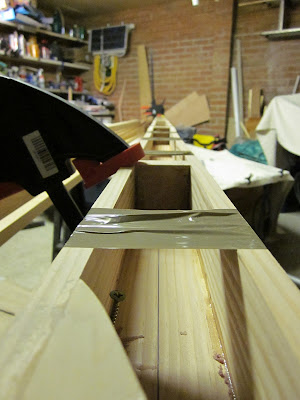All the inwale spacers are now glued in place and I could now complete the inner and outer gunwale but will hold off until the rest of the inside is complete. The seat/tank tops for the bow and stern have been cut to shape. The stern seat top was easy but the bow took a lot of shaping to be a good fit. I ended up using some scrap plywood to make a template for each side of the tank top (following the curve of the hull) before transposing this shape onto the more expensive okoume marine ply. Both tank tops now have an epoxy coating so are ready to fit. Here is a young skipper checking out the toy-storage in the bow
Before the aft tank can be sealed down I need to add a wooden pad to the inside of the transom for the rudder fixings to screw into, to know where this should be located I needed a rudder stock to offer up so this was the next job. The parts had been pre-cut some time ago and then put to one side as I was waiting to order the Seasure Pintle/gudgeon sets and some other stainless fittings. The finished tiller and rudderstock is shown below after epoxy coating.
I am changing the design a little in regard to the middle seat, the plans show a single bulkhead and simple seat with open storage below. I am going to enlarge this seat and make it enclosed for two reasons, this will reduce the amount of water in the boat after a capsize and provide some additional storage if required. It will also allow me to add some weight to the boat in the middle if I wish as there may be circumstances when I want to make the Goat more docile to sail and adding weight will help if I am sailing on my own. The middle seat it being extended forward so that it is approx. 500mm wide and this will allow me to fit up to 36litres of water ballast (24 x 1.5L water bottles = 36KG). Enclosing the middle seat causes a problem though, after a capsize both the forward and main part of the hull will need to be bailed (with a bucket most likely) so I am adding some drain holes, joined by a tube, so that as the Goat is bailed any water in the front part of the boat will (should!) run aft. The pic below shows the half-bulkheads cut out and in place but they have not been fixed yet. The drain tube is it literally that, a domestic waste water tube that is cut in half and will be bonded in place.





































